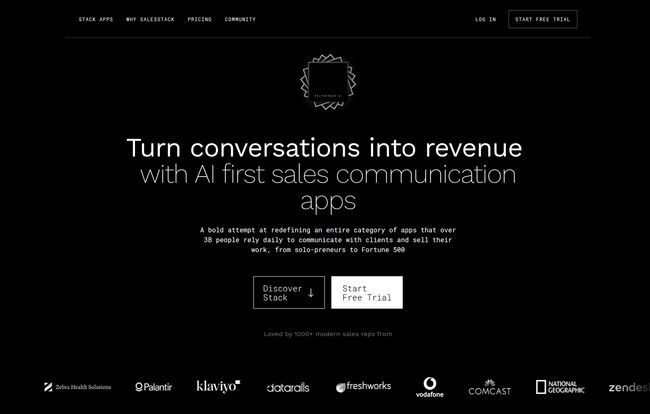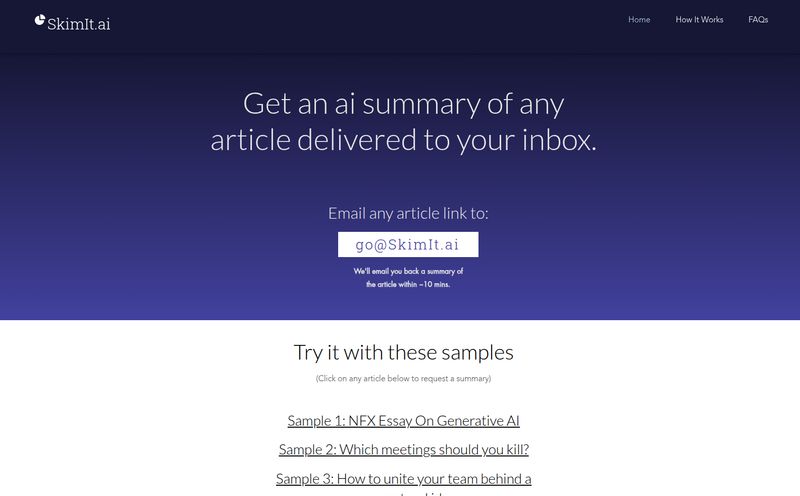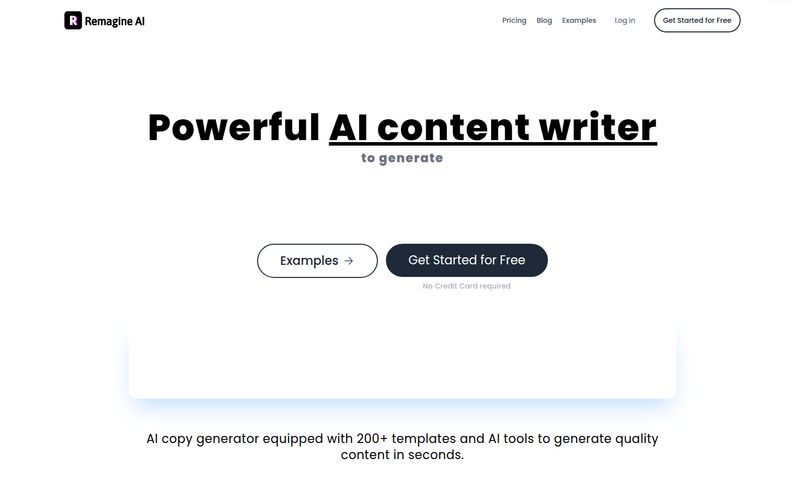We've all received them. The generic, soul-crushing LinkedIn messages. The cold emails so bland they could be used as a sleep aid. "Dear [First Name], I noticed you work at [Company Name] and I have a synergy that could revolutionize your workflow..." Ugh. Delete. Archive. Spam. It’s a digital graveyard of bad outreach out there.
For years, the promise of sales automation has been a double-edged sword. On one hand, efficiency! Scale! More shots on goal! On the other, we’ve drowned ourselves and our prospects in a sea of robotic, impersonal garbage. It’s a classic case of quantity over quality, and I think we're all getting a bit tired of it.
So when a tool like SalesStack.ai comes along, claiming it can help you “turn conversations into revenue with AI that sounds human,” my professional curiosity gets the better of me. It’s a bold claim. A very bold claim. Is this just another GPT-4 wrapper with a fancy user interface, or is there something more going on under the hood? I decided to take a look.
So What Exactly is SalesStack?
First off, SalesStack isn't just one single tool. Thinking of it that way is missing the point. It’s an integrated stack of applications designed to work together. Imagine having a little AI-powered apprentice who handles different parts of your outreach, but they all share the same brain and memories. It's designed to be the central nervous system for your client communications.
The platform is built around four core apps:
- Lead Engager: For sparking those initial conversations on platforms like LinkedIn.
- Pro Emailer: To help you draft personalized emails that don’t sound like they were written by a robot from 1998.
- Audience Engager: This one is for engaging with your prospect's content, adding thoughtful comments, and staying top-of-mind.
- Pro Caller: Helps prep you for calls by providing scripts and analyzing speech patterns.
The whole idea is to create a unified communication flow, so the AI that helps you comment on a LinkedIn post knows what was in the email you sent last week. That's a pretty big deal.

Visit Sales Stack
The Four Pillars: What Makes SalesStack Tick
During my analysis, I saw that the company bases its whole philosophy on four concepts. It's not just about the tech; its about how the tech works. And honestly, this is where it gets interesting.
Identity: The Promise of Sounding Like You
This is the big one. The holy grail. SalesStack claims its AI learns your unique style, tone, and voice. It does this by analyzing your activity, your past messages, and your profile. The goal is for the AI to become a true digital twin of your professional persona. If you’re a bit informal and use emojis, it learns that. If you’re a straight-laced, just-the-facts kind of person, it adopts that tone. This isn’t a one-size-fits-all AI voice; it’s your voice. This requires an initial training period, sure, but anything worthwhile does. You cant expect an assistant to know your style on day one, can you?
Continuity and Memory: The End of Context-Switching Hell
Have you ever had a great chat with a prospect on LinkedIn, then moved to email a week later and completely forgotten a key detail you discussed? It's embarrassing and immediately breaks rapport. SalesStack aims to fix this with Continuity and Memory. Because the apps are all connected, the AI remembers every interaction across every channel. It’s like having a perfect, searchable memory of all your conversations. This means when you go to draft a follow-up email, the AI can reference the prospect’s comment on your post from three days ago. That’s how real relationships are built – on shared context.
Privacy: A Quick But Important Note
In a world of constant data leaks and privacy concerns, SalesStack makes a point of highlighting its end-to-end encryption. All your data, all your client conversations, are protected. It's a foundational feature that should be standard everywhere but, sadly, isn't. It's good to see them taking it seriously.
Let's Talk Turkey: SalesStack Pricing
Alright, this is where the rubber meets the road for many of us. SalesStack is a premium tool, and it has a premium price tag. There’s no point in sugarcoating it. This isn't a cheap-and-cheerful plugin you grab for $10 a month.
| Plan | Price (per month) | Key Features |
|---|---|---|
| Starter | $166 | Unlimited access to all Stack Apps, team invites, AI continuity. |
| Pro | $399 | Everything in Starter, plus CRM Integration, 1-on-1 onboarding, BETA access, and team-wide fine-tuning. |
| Enterprise | Custom | Everything in Pro, plus fine-tuned models, dedicated manager, custom CRM integrations, API access. |
Looking at these numbers, the Starter plan at $166/month seems geared toward serious individual professionals or very small teams. The Pro plan at $399/month is clearly for established sales teams who need that deeper CRM integration and support. That said, one of the cons I spotted is that standard CRM integration is only on the Pro plan, and custom integrations are gated behind the Enterprise plan. That could be a sticking point for some mid-sized companies with unique tech stacks.
The Good, The Bad, and The AI
No tool is perfect. After digging in, here’s my balanced take.
What’s great is the human-like personalization. If it delivers on its promise of learning your identity, it could solve the biggest problem with sales automation. The integrated, cross-channel nature of the stack is also a massive win. It’s a genuine workflow improvement, not just a writing assistant. It acts like a BDR with a photographic memory who never needs a coffee break.
On the flip side, the price is a significant consideration. It positions SalesStack as a serious investment. Secondly, it's not magic. It requires training. You have to put in the time to let the AI learn from you, which means it won't be delivering perfect results from the very first minute. And as I mentioned, the way CRM integration is tiered might be frustrating for teams who aren't ready for the Pro or Enterprise price points but still need that connectivity. It's a classic SaaS business model, but one to be aware of.
Who is SalesStack Really For?
So, who should pull the trigger on this?
In my opinion, SalesStack is not for the casual user, the part-time freelancer, or a business on a shoestring budget. It's a power tool for power users.
It's ideal for B2B sales professionals, account executives, and full-time lead generation specialists whose entire day revolves around outreach and relationship building. If closing one extra deal a month more than covers the cost of the subscription, then it's a no-brainer. I could also see this being incredibly effective for founders and small business owners who have to handle sales themselves and need to maximize the impact of every minute they spend on it.
Frequently Asked Questions about SalesStack
- Does SalesStack integrate with my CRM?
- Yes, but it depends on your plan. Standard CRM integrations like Hubspot or Salesforce are available on the Pro plan. Custom or more complex integrations require the Enterprise plan.
- How long does it take to train the SalesStack AI?
- There's an initial setup where the AI analyzes your existing profiles and activity. However, the learning is an ongoing process. The more you use it, the better and more accurate it becomes at mimicking your style.
- Is SalesStack just another GPT wrapper?
- It seems to be more than that. While it likely uses a powerful language model at its core, the value proposition is in the fine-tuning (the 'Identity' pillar), the integrated workflow across its apps, and the 'Memory' feature that maintains context across channels. You're paying for the ecosystem, not just raw text generation.
- Can I use just one app, like Pro Emailer?
- The pricing model strongly encourages using the entire stack. The information available suggests individual apps might have a price, but the bundled 'Starter' and 'Pro' plans offer better overall value and access to the full, integrated system.
- How does SalesStack ensure my sales data is secure?
- SalesStack states that it uses end-to-end encryption for all communications and data stored within its platform, which is a critical feature for protecting sensitive client information.
My Final Verdict
So, is SalesStack the AI sales assistant we’ve been waiting for? It just might be. Or at least, it's one of the most promising contenders I’ve seen in a long time. It’s not trying to replace the salesperson. It’s trying to give them superpowers.
It correctly identifies the real problem with modern outreach: not a lack of tools, but a lack of authentic, continuous, and personalized conversation. By focusing on learning a user's unique identity and maintaining context across channels, SalesStack is tackling the very thing that makes human interaction valuable. If your revenue depends on conversations, this is a tool built from the ground up to make every single one of them count.
Reference and Sources
- SalesStack Official Website
- HubSpot's State of Sales Report (for insights on personalization trends)



